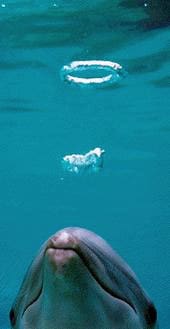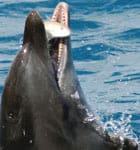Pacific Bottlenose Dolphins – Nai’a – Common to Hawaii
The Hawaiian word for dolphin is nai’a. Personalized, unhurried excursions with knowledgeable crew and limited passenger counts make our encounters unique. (See our Best of the West trips.)
Bottlenose Dolphin
Scientific Name: Tursiops truncatus
Common throughout Hawaii, they are genetically distinct from all other bottlenose dolphins world-wide, In fact, there seems to be four different populations in Hawaii, with Oahu and Maui having resident groups. Known for their inshore habitats, playfulness around vessels and captive performances at aquariums, bottlenose dolphins are probably the most popular of all cetacean species.
Adults range in size from seven to eleven feet in length and weigh between 600 and 850 pounds. Their backs are medium gray, their sides are lighter gray and their bellies are white or pink. Offshore animals are darker in color than those found inshore.
A few thousand bottlenose dolphins are believed to inhabit the waters around Hawaii, usually living in groups of two to fifteen individuals. Most of these groups are permanent residents of certain coastlines and harbors.
Bottlenose dolphins establish and maintain dominance by biting, chasing, jaw-clapping, and smacking their tails on the water. Dolphins often show aggression by scratching one another with their teeth, leaving surface wounds that heal quickly.
“Rakes” or traces of light parallel stripes remain on the skin of the dolphin. These marks have been seen in virtually all species of dolphins.
During courtship, they engage in head-butting and tooth-scratching.
Bottlenose dolphins have been seen in groups of other species such as pilot whales, spinner dolphins, spotted dolphins, and rough-toothed dolphins. They also ride pressure waves of humpback whales!
Below is a video of a bottlenose dolphin we’ve seen frequenting our coastline since the summer of 2011.
First named ‘Betty’ as we thought she was female due to her inflamed genital slit, we later found she was actually a male with some type of perhaps fungal infection (without taking samples). The condition appears to make him very itchy (and possibly underweight) and he regularly approaches boats to rub against their hulls (he does not seem to be seeking human interaction – but is specifically interested in scratching self on the boat hull).
Betty is usually seen on the periphery of the spotted dolphins commonly found near the 500 fathom depth. It is uncommon to see solitary bottlenose dolphins – ones not within a larger social pod of the same species. Solitary bottlenose are usually either unhealthy or socially unfit. Betty did spend at least a few hours with a bottlenose pod traveling near our coastline in Oct., and seemed to assimilate in just fine – which is not uncommon. We have not only seen him with the spotted, but recently with false killer whales.
Check our Facebook page to see our latest escapades. But alas, we haven’t seen Betty for a good… five+ years it seems. Still hoping!
Our wildlife tours focus on education and conservation so that an interactive relationship can be maintained in the best interest of both humans and dolphins. We strive to foster admiration and deep respect for these wonder-ful marine mammals.


